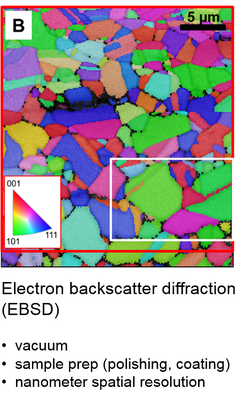Thin-film solar cell materials
Microspectroscopic imaging can provide a link between the conditions during fabrication and the macroscopic properties of materials. For example, the conversion efficiencies of thin-film solar cell materials can be influenced by their chemical composition (including contaminants, local phase segregations or formation of polymorphs) and microstructure (including crystal sizes and orientations, local stress and strain), which in turn are affected by the synthesis conditions. Raman microscopy provides access to local chemical compositions and physical properties without the need of special sample preparation or transfer of the sample into high vacuum as in electron microscopy approaches, such as electron backscatter diffraction (which indeed outperform Raman microscopy in terms of spatial resolution). This project is performed in collaboration with Dr. Daniel Abou-Ras and his colleagues at Helmholtz-Zentrum Berlin (HZB).


Quantitative crystal orientation maps of a CuInSe2 thin film
(adapted from Sci. Rep. 5 (2015) 6).
Selected publications:
T. Schmid, N. Schäfer, D. Abou-Ras, Spectroscopy Europe 28(5) (2016) 16-20.
T. Schmid, N. Schäfer, S. Levcenco, T. Rissom, D. Abou-Ras, Sci. Rep. 5 (2015) 18410.
Online attention of Scientific Reports 5 (2015) 18410:
